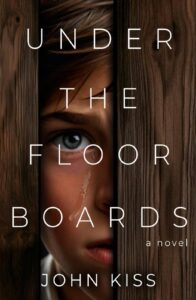Under the Floorboards by John Kiss
JOHN’S UNIQUE JOURNEY

John’s story with us is unique. John, an LGBT activist who uses the pronouns she/her, had a book inside. She was already a self-published author, having ventured into the world of independent writing on her own. But she wanted to take her manuscript to the next level, and have it be professionally edited, with the hope of having a professional publishing company publish it.
Many authors like John come to professional publishers after self-publishing, seeking the expertise and polish that can elevate their work beyond what they could achieve independently. This transition often marks a pivotal moment in an author’s career development. This was the case for John.
John’s manuscript was a novel about a true WWII story. While we loved the story, we felt that though heartfelt, it didn’t pack the emotional punch it should have for its intended adult audience. Instead, it felt more at home in the young adult (YA) genre, leaving much of its potential untapped.
Historical fiction demands a delicate balance between historical accuracy and emotional resonance, particularly when tackling subjects as weighty as WWII. The manuscript needed to mature beyond YA sensibilities to fully honor the gravity of its historical backdrop.
THE ORIGINAL MANUSCRIPT
Originally published under the title New Day Dawning, John’s story—a fictionalized account of Dr. Felix Zandman’s life—deserved far more than what it had been given. Though readers could see the flicker of something powerful beneath the surface, they felt the writing was too simple, too superficial. The novel’s heart was there, but the execution needed refinement.
Dr. Felix Zandman’s remarkable survival story during the Holocaust represents exactly the kind of narrative that benefits from skilled editorial guidance—a true account that requires the right fictional framework to illuminate its profound humanity without diminishing its historical significance.
We knew we had to do more than polish the surface—we had to breathe new life into the manuscript. This wasn’t just about improving structure or making tweaks; it was about unlocking the full emotional depth of the story. With our team of seasoned editors, we set out to transform this promising draft into a novel that could stir readers, make them feel something profound, and make the book unforgettable.
CHARACTER DEVELOPMENT CHALLENGES
The first challenge we faced was with the characters. In the original manuscript, John referred to them in broad, functional terms—”the boy,” “the doctor,” “the lawyer”. This was unique. However, some of the names did not work, for example, “the lawyer’s wife”. John felt that there was no need for a specific title for that side character. We felt that diminishing that character to just being a “wife” of a lawyer did not do her justice.
John referred to them in broad, functional terms—”the boy,” “the doctor,” “the lawyer”. This was unique. However, some of the names did not work, for example, “the lawyer’s wife”. John felt that there was no need for a specific title for that side character. We felt that diminishing that character to just being a “wife” of a lawyer did not do her justice.
We went back and forth. John’s stylistic choice, while perhaps intended to create a universal quality, inadvertently created emotional distance. Historical fiction thrives on specificity—readers need concrete individuals to follow through the landscape of history. The manuscript lacked intimacy. The characters felt distant, impersonal, and, in some cases, flat. We pushed for a specific title for that character—real, vivid role, rather than a mere “wife”. Finally, the author collaborated. We changed “the lawyer’s wife” to “the seamstress,” a choice that anchored her identity and gave her depth. This even led to the inclusion of a few new paragrphas, making the character more round and interestings. Small details, perhaps, but each one was a crucial step toward breathing life into these figures.
These naming decisions represent one of the most fundamental aspects of character development in historical fiction—the transformation from archetype to individual. By giving characters specific identities rather than generic labels, we invite readers to form emotional attachments that sustain engagement throughout the narrative.
CRAFTING EMOTIONAL ARCS
Equally important was the development of character arcs. Initially, John’s characters were compelling, but they lacked the emotional trajectory that would allow readers to invest deeply in their journeys. We took each character and worked with John to craft arcs that were rich, layered, and transformative. This wasn’t just about creating challenges for them to overcome—it was about creating real, tangible growth. By the end of the book, we wanted readers to feel like they had traveled through an emotional labyrinth with these characters, to feel the weight of their struggles, and experience the catharsis that comes with their resolutions.
The emotional architecture of a novel is as important as its plot structure. Each character needs not just external goals but internal conflicts that evolve over time. In historical fiction particularly, showing how historical events shape and transform characters creates the essential connective tissue between past events and present readers.
STRUCTURAL REFINEMENT

As we moved into the developmental phase, the novel’s structure was another key challenge. John had chosen to work with dual timelines, but the chapters, though intriguing, were too disjointed. The transitions were abrupt, and the narrative felt fractured. We slowed down the pace, expanded certain chapters, and reworked the flow to ensure that the story unfolded in a way that felt organic. We insisted that every chapter, every scene, had to serve the story—it had to propel the narrative forward or deepen the emotional resonance. We added scenes that built tension, ones that kept the reader on the edge of their seat, while trimming others that didn’t serve a greater purpose.
Dual-timeline narratives require exceptional editorial attention to maintain narrative cohesion. Each timeline must not only tell its own compelling story but also enhance and illuminate the other, creating resonances and revelations that would be impossible in a linear narrative.
EMOTIONAL DEPTH AND TONE
The emotional tone of the book needed an overhaul as well. Some scenes had the potential to break hearts, but they were too brief—too fleeting. We worked tirelessly to extend those moments, drawing out their impact. Every emotion—whether sorrow, joy, fear, or hope—had to feel like a live wire running through the narrative, electrifying the reader. We dug deep, focusing on the language, making sure every sentence was not just functional, but lyrical, painting pictures that would linger in the reader’s mind long after they turned the page.
TIMELINE MANAGEMENT
The dual timelines, while a brilliant concept, also needed refining. The original structure, though bold, was chaotic, and the chapters often jumped from one timeline to another without offering enough context to ground the reader. We insisted on adding titles to each chapter that indicated time and place—simple but essential markers that would allow readers to orient themselves in the shifting landscape of the story. The dual timelines needed to complement each other, to feel like two rivers that met at the same destination, not two disconnected stories.
We smoothed out the transitions, ensured each timeline served the greater narrative, and crafted chapters that were substantial enough to hold the weight of both stories.
Signposting is a subtle but essential craft element in complex narrative structures. Clear temporal and spatial markers create a reading experience that challenges without confusing, allowing readers to surrender to the emotional journey without struggling to maintain their bearings.
NARRATIVE FOCUS
A particularly difficult but essential decision was to trim unnecessary scenes—ones that, though interesting in their own right, didn’t belong in the larger tapestry of the book. Editorial courage sometimes means recognizing when interesting material doesn’t serve the core narrative. Historical fiction often tempts authors to include fascinating historical details or figures that they’ve researched, but narrative cohesion must always take precedence over historical inclusivity.
For example, a subplot involving a character based on Gertrude Stein visiting Parisian museums didn’t add to the heart of the story. It was colorful, yes, but it detracted from the emotional intensity we were working to create. We made the tough call to remove these scenes, shifting the focus back to the heart of the novel: the human experience, the survival, the love, and the loss.
ABSTRACT TO CONCRETE
We also turned our attention to the more abstract elements of the story—sections that delved into math and philosophical concepts. While they were thought-provoking, they felt out of place in a narrative that was already so emotionally rich. We replaced these with more visual, visceral moments: discussions about the Fibonacci sequence and the elegance of bird flight formations. These new elements were not only more engaging but grounded the story in something tangible, something the reader could imagine and feel.
Abstraction in fiction works best when anchored to sensory detail. By transforming mathematical concepts into visual imagery, we created moments of intellectual beauty that enhanced rather than interrupted the emotional flow of the narrative.
PERSONAL CONNECTION
Finally, we convinced John to add a personal note to the narrative—something that would tie her own story to the novel. Though initially resistant, she eventually agreed, understanding that her personal connection to the story was one of its greatest strengths. Given her background—four generations of World War II survivors—it was impossible to separate the narrative from John’s own family’s history. The personal introduction and author’s note at the end became a bridge between John’s personal journey and the one she had crafted as the novel. It gave the reader insight into the heart behind the words and drew them deeper into the story, making the experience even more profound.
Author’s notes in historical fiction serve as crucial paratextual elements that contextualize the narrative and authenticate the author’s relationship to the material. For stories dealing with historical trauma, establishing the author’s personal stake or connection creates an ethical framework that reassures readers about the author’s intentions and qualifications.
TRANSFORMATION COMPLETE
What began as a promising manuscript—good but not great—was transformed into a work of properly written historical fiction. Through a delicate process of collaboration, vision, and relentless editing, we unlocked the true power of John’s story. Under the Floorboards became more than just a novel about survival; it became a testament to resilience, love, and the human spirit. It’s a book that resonates deeply, one that stays with you long after you’ve finished reading.
